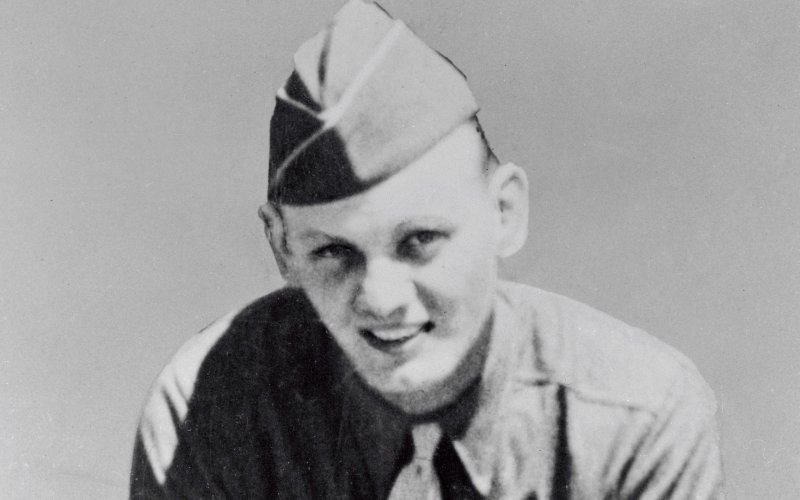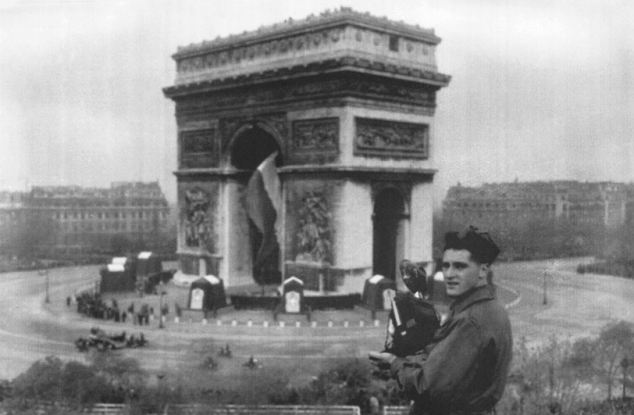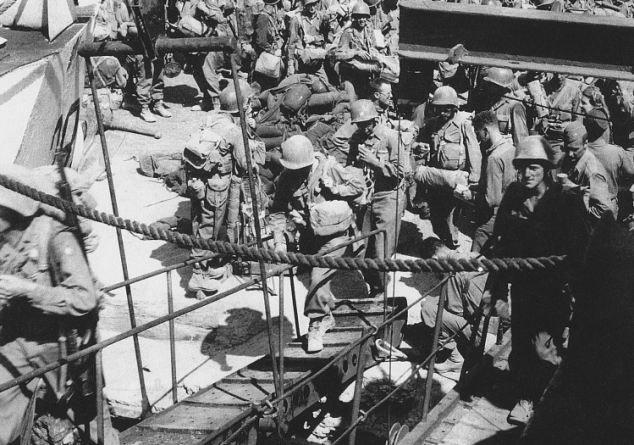The book The Deserters: A Hidden History of World War II, by Charles Glass, tells an interesting WWII story that not many have heard – the story of the deserters. A deserter is a military term used for soldiers who have left their posts without permission. Unlike the term Absence Without Leave (AWOL) used for soldiers who leave their posts temporarily, “deserters” refers to those who have no intention of ever returning to the line of duty. With his book, Glass sheds light on this long-neglected phenomena.
Official U.S. Army photograph, taken a Pozzuoli near Naples in August 1944, that happened to capture Private First Class Steve Weiss boarding a British landing craft. He is climbing the gangplank on the right-hand side of the photograph.”
Glass interviewed and surveyed 150,000 American and British soldiers that deserted their posts for good during WWII. He also used army archives, personal diaries, memoirs, and court-martial records to get a clearer picture of the lives of ordinary soldiers fighting in the front lines, and why they abandoned their posts. The Deserters: A Hidden History of World War II tells the story of three deserters in France, Italy and Africa.
It was when Glass happened to meet soldier Steve Weiss that the writing of his book about American and British deserters of the Second World War really took off. With idealistic ideas of war, Private Steve Weiss enlisted into the army, as a teenager and not even 18 years old yet (the legal age to join). Weiss eventually became disillusioned about the nobility of war and became a deserter, joining gangs of American soldiers in Paris that turned to a life of crime instead of fighting for their countries. Another story of a deserter is about Private Alfred Whitehead, who received silver and bronze stars for bravery, but also deserted the war to join a gang in Paris. These gangs regularly robbed allies as well as ordinary citizens for self-gain.
Gangs of deserters were extremely violent, were heavily armed with stolen weapons, and had an appetite for raping young girls. Evidence of these crimes can still be traced by looking at the reported cases investigated by American forces. In the years preceding the end of the war (1944- 1945), when deserter violence was especially rife, the Criminal Investigation Branch (CBI) of the US Army handled 7,912 cases related to deserter crimes.
“In the American army, only about 10 percent of the soldiers in uniform actually saw combat,” Glass tells Fresh Air’s Dave Davies, “and they were very rarely rotated out of the fronts. Most of the people [who] deserted were those who broke down in battle. … That figure of 50,000 … is extremely high given the number of men who were actually at the front.”
Glass, a veteran journalist and author of Americans In Paris: Life and Death Under Nazi Occupation, also points out how difficult it was to identify which men might crack under the pressures of war.
“It’s very hard to know which ones will and which ones won’t,” he says, “and the men themselves going into battle didn’t always know. Some of those who were extremely gung-ho in training were the very first to break down in combat.”

44% of these investigated crimes were crimes of violence like rape, murder, man-slaughter and assault. 12% were crimes like robbery, housebreaking and rioting. About 40% included crimes of corruption against the US army, involving stolen weapons, forged passes, and hijacked vehicles, to name but a few. Of all the European cities, Paris was struck the hardest with these crimes of violence from American soldiers.
Steve Weiss’ desertion
“Under that severe strain, one night in the middle of the night he wandered off in a daze. And other deserters said this — that they didn’t make a conscious decision, but they just found their bodies leading them away from the front — and he wandered into the woods, found a barn and slept for a couple of days, put himself back together and then reported again for duty. And that was clearly not a conscious desertion.” source npr.org
In the weeks following liberation from the Nazis, Paris was struck by a wave of such violent crimes that rivaled the effects of the war itself. These were men that took up the opportunity for self-gain during a time of global chaos. Paris was especially appealing to these men, with the city’s famous cafés and brothels to entertain them. The city was also rife with black-markets and soldiers who generated an income by selling stolen weapons from their comrades and allies who needed the weapons to survive in the front line of battle. Deserters were branded as cowards and men who should be ashamed of themselves and their actions. Yet, the life of crime they chose was just as violent and dangerous as the war they escaped.
Not all deserters were engaged in such criminal activities. Rather, “deserter” is an umbrella term that included various types of men who had one thing in common – desertion. Take British soldier Private John Bain, for example, who deserted his post several times, yet still took part in combat in Africa and France. And how about Eddie Slovik who never fought a battle. Unlike most deserters he never tried to escape; he was much more content with life in prison than on the battlefield. Slovik was also the only man who was executed out of 49 Americans that were sentenced to death for desertion during the Second World War.
As can be seen by the different stories above, these men had many reasons for deserting their posts. Many were afraid for their lives and were pushed to their physical and psychological breaking point. Some described their moment of desertion as waking from a dream only to find that their bodies had led them away from the battlefield as if in a daze. Can anyone blame them for what they did?

With his book The Deserters, Glass attempts to reveal the true experience of the soldiers in the front line; an account that won’t be found in the history books. It reveals the harsh and gruesome truth of life during the Second World War and what soldiers needed to do to survive the loneliness, violence, and life-threatening danger they were forced into.

